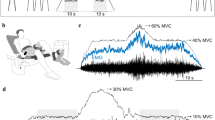Abstract
A new method of modulated kinesotherapy (MK) involving foot-paced movement (walking and running) with the pace and heart rate synchronized by means of a specially developed Marafon training device is described. In healthy subjects and patients with coronary disease complicated by functional class I or II (FC I–II) angina, the heart rate (HR) decreased by 20–25% during the MK; after the MK, the period of normalization of the HR decreased by 30%, relative to the control. The double product index, an integral representation of the circulatory efficiency, decreased by 15–20%. Normalization of the systolic component (on the average, 62.4 and 64.2% increase in the stroke volume and the end-diastolic volume, respectively) and diastolic function (40 and 43% increase in the peak left ventricular early filling rate and the ratio of the peak early filling rate to the atrial filling rate, respectively) was observed. The indications for and the contraindications to the MK application are specified.
Similar content being viewed by others
REFERENCES
Amosov, N.M. and Bendet, Ya.A., Fizicheskaya aktivnost'i serdtse (Physical Activity and Heart), Kiev: Zdorov'e, 1989.
Nikolaeva, L.F. and Aronov, D.M., Reabilitatsiya bol'nykh ishemicheskoi bolezn'yu serdtsa: Rukovodstvo dlya vrachei (Rehabilitation of Patients with Coronary Disease: Physicians' Guide), Moscow: Meditsina, 1988.
Kulikov, V.P., Efremushkin, G.G., Aksenov, A.V., et al., The Efficiency of Arbitrary-Chosen Physical Training in Healthy Subjects and Patients with Myocardial Infarction, Kardiologiya, 1994, no. 8, p. 29.
Lechebnaya fizkul'tura v sisteme meditsinskoi reabilitatsii (Exercise Therapy in Rehabilitation System), Kaptelina, A.F. and Lebedeva, I.P., Eds., Moscow: Medicine, 1995.
Karpman, V.L. and Abrikosova, M.A., Several Mechanisms of Human Cardiovascular Adaptation to Physical Exercise, Uspekhi Fiziol. Nauk, 1979, no. 2, p. 97.
Zemtsovskii, E.V., Sportivnaya kardiologiya (Sports Cardiology), St. Petersburg: Gippokrat, 1995.
Levi, M.N. and Martin, P.Yu., Neurohumoral Regulation of the Heart Work, in Fiziologiya i patofiziologiya serdtsa, Sperclakis, N.M., Ed., T. 2 (Heart Physiology and Pathophysiology. Vol. 2), Moscow: Meditsina, 1990, vol. 2, p. 64.
Winkle, R.A., The Relationship between Ventricular Ectopic Beat Frequency and Heart Rate, Circulation, 1982, vol. 66, p. 439.
Aronov, D.M., Functional Tests in Cardiology, Kardiologiya, 1995, no. 3, p. 74.
Golub, Ia.V., Golub, V.I., and Golub, I.V., Device for Optimization of the Circulatory Function in Humans, RF Patent Priority Reference No. 99127570/20(028634).
Golub, Ia.V., Golub, V.I., Golub, I.V., et al., Method for Optimization of the Circulatory Function in Humans, RF Patent Priority Reference No. 2000131759/20(028634).
Ulmer, G., Bryuk, K., Valdek, F., et al., Translated under the title Fiziologiya cheloveka. T. 4 (Human Physiology), Moscow: Mir, 1986, vol. 4.
Morman, D. and Heller, L., Fiziologiya serdechno-sosudistoi sistemy (Physiology of Cardiovascular System), St. Petersburg: Izd. Piter, 2000.
Paleev, N.R. and Pronina, V.P., Noninvasive Assesment of the Severity of Heart Failure in Patients with Myocarditis, Myocarditial Cardiosclerosis, and Dilated Cardiomyopathy, Kardiologiya, 1999, no. 6, p. 39.
Grassi, G., Gavazzi, C., Capozi, A., et al., Alterations in Plasma Norepinephrine to Lower Body Negative Pressure in Humans, Amer. J. Physiol., 1982, vol. 243, p. 970.
Levy, M.N., Ng, M., Martin, P., and Zieske, H. Sympathetic and Parasympathetic Interactions upon the Left Ventricle of the Dog, Circ. Res., 1969, vol. 19, p. 5.
Thoren, P. and Lundin, S., Autonomic Nervous System and Blood Pressure Control in Normotensive and Hypertensive Conditions, in Central Cardiovascular Control. Basic and Clinical Aspects, Berlin, 1983, p. 31.
Zipes, D.P. and Knoebel, S.B., Rapid Rate-Dependent Ventricular Ectopy. Adverse Responses to Atropine-Induced Rate Increase, Chest, 1972, vol. 62, p. 255.
Wit, A.L. and Rosen, M.R., Pathophysiologic Mechanism of Cardiac Arrythmias, Am. Heart J., 1983, vol.106, p. 798.
El-Sherif, N., The Ventricular Premature Complex: Mechanisms and Significance, in Cardiac Arrythmias: Their Mechanisms, Diagnosis, and Management, Mandel, W.J., Ed., Baltimor, 1980, p. 288.
Alekperov, I.I., Sokolov, S.F., and Popov, A.Yu., The Analysis of the Relationship between the Ventricular Ectopic Beats and the Heart Rate, Kardiologiya, 1998, no. 5, p. 24.
Khaulike, I., Vegetativnaya nervnaya sistema (Autonomic Nervous System), Bukharest: Med. Izd., 1978.
Author information
Authors and Affiliations
Rights and permissions
About this article
Cite this article
Golub, I.V. Physiological Mechanisms of the Effect of Modulated Kinesotherapy on the Circulatory System. Human Physiology 28, 747–752 (2002). https://doi.org/10.1023/A:1021172927503
Issue Date:
DOI: https://doi.org/10.1023/A:1021172927503




